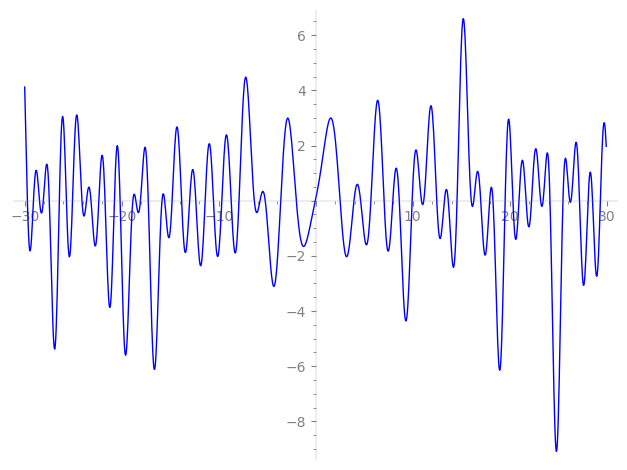| L(s) = 1 | + (0.269 + 0.155i)2-s + (−0.891 − 0.514i)3-s + (−0.951 − 1.64i)4-s + (−0.160 − 0.277i)6-s + 3.28i·7-s − 1.21i·8-s + (−0.969 − 1.67i)9-s − 5.16·11-s + 1.95i·12-s + (3.06 − 1.76i)13-s + (−0.510 + 0.883i)14-s + (−1.71 + 2.96i)16-s + (−0.874 − 0.504i)17-s − 0.603i·18-s + (−2.42 + 3.62i)19-s + ⋯ |
| L(s) = 1 | + (0.190 + 0.109i)2-s + (−0.514 − 0.297i)3-s + (−0.475 − 0.824i)4-s + (−0.0653 − 0.113i)6-s + 1.23i·7-s − 0.429i·8-s + (−0.323 − 0.559i)9-s − 1.55·11-s + 0.565i·12-s + (0.849 − 0.490i)13-s + (−0.136 + 0.236i)14-s + (−0.428 + 0.742i)16-s + (−0.211 − 0.122i)17-s − 0.142i·18-s + (−0.555 + 0.831i)19-s + ⋯ |
\[\begin{aligned}\Lambda(s)=\mathstrut & 475 ^{s/2} \, \Gamma_{\C}(s) \, L(s)\cr =\mathstrut & (-0.950 - 0.311i)\, \overline{\Lambda}(2-s) \end{aligned}\]
\[\begin{aligned}\Lambda(s)=\mathstrut & 475 ^{s/2} \, \Gamma_{\C}(s+1/2) \, L(s)\cr =\mathstrut & (-0.950 - 0.311i)\, \overline{\Lambda}(1-s) \end{aligned}\]
Particular Values
| \(L(1)\) |
\(\approx\) |
\(0.0103990 + 0.0651140i\) |
| \(L(\frac12)\) |
\(\approx\) |
\(0.0103990 + 0.0651140i\) |
| \(L(\frac{3}{2})\) |
|
not available |
| \(L(1)\) |
|
not available |
\(L(s) = \displaystyle \prod_{p} F_p(p^{-s})^{-1} \)
| $p$ | $F_p(T)$ |
|---|
| bad | 5 | \( 1 \) |
| 19 | \( 1 + (2.42 - 3.62i)T \) |
| good | 2 | \( 1 + (-0.269 - 0.155i)T + (1 + 1.73i)T^{2} \) |
| 3 | \( 1 + (0.891 + 0.514i)T + (1.5 + 2.59i)T^{2} \) |
| 7 | \( 1 - 3.28iT - 7T^{2} \) |
| 11 | \( 1 + 5.16T + 11T^{2} \) |
| 13 | \( 1 + (-3.06 + 1.76i)T + (6.5 - 11.2i)T^{2} \) |
| 17 | \( 1 + (0.874 + 0.504i)T + (8.5 + 14.7i)T^{2} \) |
| 23 | \( 1 + (6.63 - 3.83i)T + (11.5 - 19.9i)T^{2} \) |
| 29 | \( 1 + (2.01 + 3.48i)T + (-14.5 + 25.1i)T^{2} \) |
| 31 | \( 1 + 4.60T + 31T^{2} \) |
| 37 | \( 1 - 6.48iT - 37T^{2} \) |
| 41 | \( 1 + (-3.40 + 5.89i)T + (-20.5 - 35.5i)T^{2} \) |
| 43 | \( 1 + (5.46 + 3.15i)T + (21.5 + 37.2i)T^{2} \) |
| 47 | \( 1 + (-3.32 + 1.92i)T + (23.5 - 40.7i)T^{2} \) |
| 53 | \( 1 + (6.16 - 3.55i)T + (26.5 - 45.8i)T^{2} \) |
| 59 | \( 1 + (-6.73 + 11.6i)T + (-29.5 - 51.0i)T^{2} \) |
| 61 | \( 1 + (3.06 + 5.31i)T + (-30.5 + 52.8i)T^{2} \) |
| 67 | \( 1 + (-9.69 + 5.59i)T + (33.5 - 58.0i)T^{2} \) |
| 71 | \( 1 + (-0.227 + 0.394i)T + (-35.5 - 61.4i)T^{2} \) |
| 73 | \( 1 + (3.57 + 2.06i)T + (36.5 + 63.2i)T^{2} \) |
| 79 | \( 1 + (-1.44 + 2.50i)T + (-39.5 - 68.4i)T^{2} \) |
| 83 | \( 1 + 5.50iT - 83T^{2} \) |
| 89 | \( 1 + (3.56 + 6.17i)T + (-44.5 + 77.0i)T^{2} \) |
| 97 | \( 1 + (9.37 + 5.41i)T + (48.5 + 84.0i)T^{2} \) |
| show more | |
| show less | |
\(L(s) = \displaystyle\prod_p \ \prod_{j=1}^{2} (1 - \alpha_{j,p}\, p^{-s})^{-1}\)
Imaginary part of the first few zeros on the critical line
−10.54066200408440172721474831203, −9.681355970485950842822229924378, −8.717659021260646171862620580386, −7.907119031074305995769225560483, −6.33006058331029380728282262210, −5.74345084396075726433924440445, −5.20445122753549504488795319625, −3.60819383771314825700735508131, −2.00247008171763100767509889759, −0.03815518478951578280081739480,
2.51260470612312582947567855541, 3.94288792036145514134473985951, 4.62810042169334316423267044154, 5.68544420850676684501925294876, 7.04322617377357204805915703109, 7.944474362819047000955080718074, 8.613858103824497708540616003371, 9.938791602407527110984978917880, 10.90090705603377820722169560175, 11.13666535350970274640568970837

